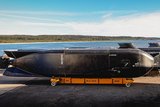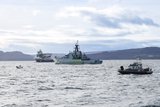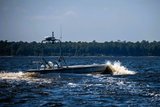AN/AQS-20A sonar set for improvements
Raytheon and the US Naval Undersea Warfare Center (NUWC) are working to improve the capabilities of the US Navy’s AN/AQS-20A minehunting sonar, the company announced on 27 August.
Under a 'work for private party' contract funded by Raytheon, the team is analysing the AN/AQS-20A’s synthetic aperture sonar to improve its ability to capture and process high- and low-resolution images of underwater mines.
The enhancements will enable the sonar to produce better quality images of objects found deep under water to aid in the identification and classification of mines. A series of lab- and sea-based tests will be carried out to evaluate and exercise the sonar's features to optimise the quality of both high- and low-resolution imaging.
The AN/AQS-20A is the variable depth sonar for the AN/WLD-1 Remote Minehunting System (RMS) deployed from the navy’s Littoral Combat Ship (LCS). The system is towed undersea to simultaneously scan the water column for anti-shipping mines forward of, to the sides, and beneath the vehicle. Sophisticated sonar, electro-optical sensors, and high-precision location information are used to provide high-resolution images of mines and mine-like objects.
Kevin Peppe, vice president of Raytheon Integrated Defense Systems' Seapower Capability Systems, said: ‘Extending our long history of collaboration with our NUWC neighbours, this project brings together our respective sonar experts to maximise the performance of a critical undersea warfare capability. Our goal is to build on the system's proven performance and further the advantage that AN/AQS-20A provides to the navy to safely detect and effectively identify these undersea threats.’
More from Naval Warfare
-
![How the Anduril-HHI autonomous ship plan fits in with the US Navy’s MASC programme]()
How the Anduril-HHI autonomous ship plan fits in with the US Navy’s MASC programme
The new modular vessel is expected to be developed for both commercial and defence use, with a heavy focus on production speed and mission flexibility.
-
![Indo Pacific 2025: Autonomous systems reigned but can the Australian Defence Force afford it?]()
Indo Pacific 2025: Autonomous systems reigned but can the Australian Defence Force afford it?
Multiple autonomous systems and technologies were on display at this year’s Indo Pacific, but questions remain over how the Australian Department of Defence will balance the books.
-
![How the UK Royal Navy is powering up its hybrid fleet to combat new threats]()
How the UK Royal Navy is powering up its hybrid fleet to combat new threats
Since it announced its move towards a new “hybrid navy” earlier this year, the force has announced a number of new uncrewed technologies in the works.
-
![US and UK to begin Trident II D5 Increment 8 in October 2026]()
US and UK to begin Trident II D5 Increment 8 in October 2026
Trident II D5 Increment 8 will involve improvements to the shipboard navigation subsystem for the US Ohio and Columbia and the UK Dreadnought and Vanguard submarine classes.
-
![US Navy starts acquisition process for uncrewed maritime systems for support missions]()
US Navy starts acquisition process for uncrewed maritime systems for support missions
The USN is interested in uncrewed capabilities that can carry out explosive ordnance disposal, mine countermeasures, force protection, ISR and anti-submarine missions.






















